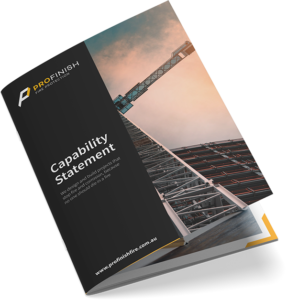Want to know the most important factor for implementing effective fire safety in high-rise and multi-storey buildings? Planning. The safest fire protection systems found in multi-storey towers and apartment buildings are designed into the building plans well before construction begins. Adequate fire protection is absolutely critical to the integrity of a building’s structure. This is especially true of high-rise buildings where the internal structure supports immense weight and the building caters to vastly higher occupancy numbers. The consequences of structural damage due to fire are far too great, so the risk has to be minimised as much as possible. At PROFINISH Fire Protection, we’ve worked closely with developers and architects to design complete passive fire protection solutions for multiple high-rise buildings.
Why do high-rise buildings need extreme fire safety?
High-rise buildings present a number of unique fire safety challenges to developers, architects, occupants and firefighters. Passive fire protection is crucial in preventing the vertical spread of fire and its damaging effects. In other words, defence is the best offence in higher structures.
If a high-rise building’s structural components are weakened during a fire, the building could collapse.
This sort of disaster presents extreme danger to the occupants as well as surrounding buildings. The building must be able to withstand prolonged fire exposure to give occupants time to evacuate and to slow the spread as much as possible so active fire systems are more effective in controlling the fire.
Full building evacuation is difficult.
Because occupants have to escape vertically, full evacuation can be difficult if a fire has broken out. Many buildings have a ‘defend in place’ emergency strategy, but this is a last resort. If fire spread is effectively slowed, occupants have more time to execute a successful evacuation.
Firefighting can be ineffective on upper levels.
As emergency resources mainly fight the fire from ground level in a critical situation, they are limited in reaching the upper floors of a high-rise building.
Active Fire Protection systems can be compromised.
Active fire protection systems such as sprinklers and fire doors rely on public utilities. If for any reason the water or electrical supply falters, sprinklers and other automated systems may not be effective.
The only way to ensure fire safety in high-rise buildings is by implementing a complete passive fire protection system during planning and construction. This will ensure your building’s fire safety and guarantee compliance with the Building Code of Australia while achieving the necessary Fire Resistance Level.
What elements need passive fire protection in high-rise buildings?
One of the most important aspects of passive fire protection is effective compartmentation so that fire and smoke cannot spread from the point of ignition. PROFINISH Fire Protection uses a range of certified products to treat potentially hazardous building components. These are installed and applied by highly experienced team members to meet the required FRLs.
Service & Air Ducts
High-rise commercial buildings are built with an intricate network of ducts to regulate airflow. As these ducts breach walls, they require specific treatment to stop the spread of heat and fire both through and around them. The passive fire protection of ducts is most commonly achieved by the application of CAFCO Promaspray 300 vermiculite spray. Ducts can also be treated through the application of fire wrap and or fire retardant board.
Pipes & Compartments
As services run through firewalls, these can double as openings where fire, heat and smoke can potentially spread. To stop this from happening, passive fire protection helps to seal these penetrations that otherwise form weak points.
Fire-stopping penetration treatments and applications that help stop the spread of flames include:
- Collars
- Fire Wrap
- Fire Strips
- Acrylic Sealant
- Fire Proof Mortar; and
- Fire Proof Grafitex
Structural Steel
Commonplace in modern multi-storey buildings, steel-framed construction remains favourable for its strength and durability. The major downside is that its load-bearing capacity is significantly reduced when exposed to extreme heat. The application of a fire protection product such as Vermiculite spray or Intumescent Paint can drastically increase steel’s fire resistance.
Vermiculite fire spray consists of cement fibres, vermiculite and plaster. It is highly effective at retaining moisture, which turns to steam in extreme heat and has a cooling effect on the steel, delaying the increase in temperature.
Intumescent Paint is a specialised coating that insulates the surface of structural steel. As steel loses its load-bearing capacity when its temperature rises above 550ºC, intumescent paint reacts and swells to form a protective layer. ProFinish Coatings is one of few Australian companies certified as an applicator of CAFCO Sprayfilm intumescent paint.
Aesthetic Materials
Contemporary design features such as exposed steel and timber beams can pose fire risks if not treated with a fire protection coating. To maintain the aesthetic appearance of these materials, PROFINISH Fire Protection can apply thin film intumescent paint. Various topcoat options are available to give the desired colour finish.
When should I ask PROFINISH Fire Protection to assist in specifying a system for my building?
Contact us as soon as your project has been initiated so we can work with you to design a complete passive fire protection system from the ground up. We’ve worked on a number of major construction projects and high-rise buildings which you can view in our latest projects. If you’d like to know more about designing fire safety in high-rise buildings, get in touch with our team by phone (03) 5274 1226, email estimating@profinishfire.com.au or via our contact form.

